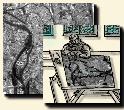 |
 |
![]()
Introduction
![]()
The availability of remote sensing images of high resolution allows today the making of maps and spatio-cards more and more accurate. The rate of shots ensures a tracking of the evolution of the sites processed. This induces a regular updating of the maps.
Cards are produced manually. Data input is carried out by means of software dealing with the drawing of lines and curves. The semantic contents of each element are deduced from
Producing maps is often a long and boring process, and more or less automatic tools have been created, in the aim of helping the elaboration of these maps. The following pages present some of these methods.
The extraction of geometric structures often does not make it possible to deduce their nature. A linear element represents any type of highway, and analyzing its characteristics such as curve, slope..., is not always sufficient to determine its nature. In this situation, the contribution of out-image data often helps raising uncertainty. In the case of an automatic process, thematic data bases can be useful for the identification of entities.
The crucial problem in this type of processing is the precision of data. The data bases available are often old and/or vague. The longer is the time separating the construction of the data base and the shots, the more the risk of disparity between the elements detected and those present in the data bases is high. Moreover, the inaccuracy of the data does not make it possible to easily match an element detected on the image with its representation in the data bases.
The traditional approach, used for updating data bases vectors, consists of the following stages:
The inaccuracy of the input data leads to an inaccuracy on the output data. These errors are of different natures:
The knowledge of the nature of the elements stored in the data base is often uncertain